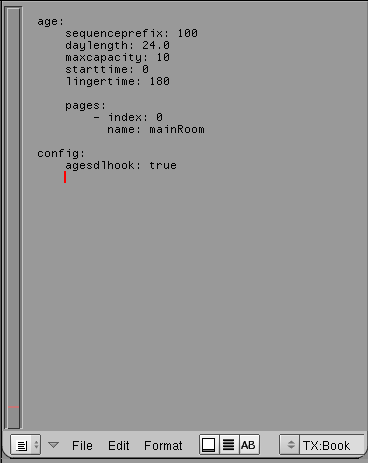Difference between revisions of "Setting Your Age Up"
(→Adding a book: Typo fix) |
(→Adding a book: minor changes) |
||
| Line 25: | Line 25: | ||
You can see that there are various properties to be set. | You can see that there are various properties to be set. | ||
| − | Most of these properties are not interesting at this time, but two of them are | + | Most of these properties are not interesting at this time, but two of them are important to know about: |
| − | * '''age.sequenceprefix''' | + | * '''age.sequenceprefix''' |
| − | Each age for uru has it's own unique id number - the sequence prefix. There can't be two ages on an uru installation that share the same sequence prefix, otherwise uru will just crash. | + | *:Each age for uru has it's own unique id number - the sequence prefix. There can't be two ages on an uru installation that share the same sequence prefix, otherwise uru will just crash. |
| − | For now, the default sequence prefix of 100 is ok for a local testing age, but when you want to release your age, you will have to change this number to a unique one. | + | *:For now, the default sequence prefix of 100 is ok for a local testing age, but when you want to release your age, you will have to change this number to a unique one. |
| − | * '''age.pages''' | + | * '''age.pages''' |
| − | The '''age.pages''' property is a list (indicated by the dash sign) of page descriptions. Each page description has at least two properties - '''index''' - the index number of the page, and '''name''' - the name of the page | + | *:The '''age.pages''' property is a list (indicated by the dash sign) of page descriptions. Each page description has at least two properties - '''index''' - the index number of the page, and '''name''' - the name of the page |
| − | Contents of uru ages are often separated into separate pages, with separate names. | + | *:Contents of uru ages are often separated into separate pages, with separate names. |
| − | For now, one page called "mainRoom" will be sufficient. | + | *:For now, one page called "mainRoom" will be sufficient. |
Note: the Book file used the same structure as [[Beginner's_Guide_to_AlcScript | AlcScript]] | Note: the Book file used the same structure as [[Beginner's_Guide_to_AlcScript | AlcScript]] | ||
Revision as of 12:50, 14 January 2008
For starter, we will begin with a new blank blender session.
Contents
Preparing the blender screen
Pprepare your blender screen so it looks something like this:

Window 1 is a 3D View Window 2 is a Text Editor Window 3 is a Scripts Window Window 4 is a Buttons Window
Haveing these windows like this is not a necessity, but it will make following this tutorial a bit easier.
Adding a book
Each age needs certain information to describe the basics of how it operate. In PyPRP and Blender, this information is stored in a text file (a text file that is stored inblender internally, to be precise).
To add a default version of such a text file, go to the Scripts Window, and press Scripts->Add->PyPRP.
Now select "Add Book" from the popup menu.
Congratulations, you just added a text file to blender.
Now in the text window, press the button with the two arrows, and select "Book" from the popup menu that shows.

Your text window should now show this:

You can see that there are various properties to be set. Most of these properties are not interesting at this time, but two of them are important to know about:
- age.sequenceprefix
- Each age for uru has it's own unique id number - the sequence prefix. There can't be two ages on an uru installation that share the same sequence prefix, otherwise uru will just crash.
- For now, the default sequence prefix of 100 is ok for a local testing age, but when you want to release your age, you will have to change this number to a unique one.
- age.pages
- The age.pages property is a list (indicated by the dash sign) of page descriptions. Each page description has at least two properties - index - the index number of the page, and name - the name of the page
- Contents of uru ages are often separated into separate pages, with separate names.
- For now, one page called "mainRoom" will be sufficient.
Note: the Book file used the same structure as AlcScript
Adding default fog settings
The fog settings for uru are also set in a text file in blender - this file corresponds directly to the files with extention ".fni" in uru. Since you get annoying fog settings by default, we should add a text file that has settings that don't give fog.
To add this "init" text file, go to the Scripts Window, and press Scripts->Add->PyPRP. Now select "Add Default age fni settings" from the popup menu.
The contents ofthat file will look like this:

Adding a default AlcScript file
Before continuing, it is a good idea to add a third text file to your blender file, that one will be empty, but will be the place where you can set advanced settings for your objects later on.
To add the "AlcScript" text file, go to the Scripts Window, and press Scripts->Add->PyPRP. Now select "Add Default AlcScript" from the popup menu.
Continue
We are done with setting up the blender file, let's continue with Adding a bit of surface
